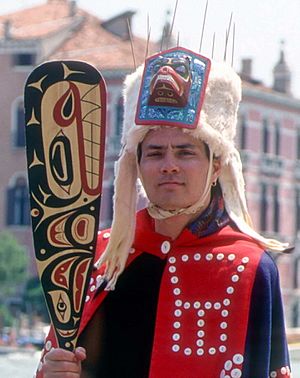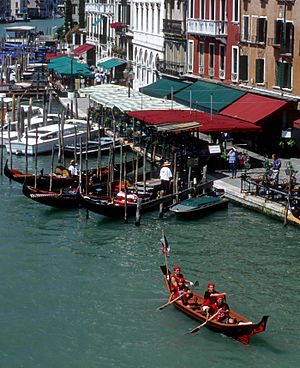David Neel facts for kids
David Anthony Neel (born April 7, 1960) is a talented Canadian writer, photographer, and artist. He is a member of the Kwakwaka'wakw First Nation, an Indigenous group from the coast of British Columbia.
Contents
About David Neel
David Neel was born on April 7, 1960, in Vancouver, British Columbia. He is a Canadian artist from Fort Rupert, British Columbia, known for working with many different art forms. He trained to be a professional photographer in the United States for several years. In 1987, he returned to Vancouver, which was a big moment for him. Soon after, he began creating art in the style of his father's people, the Kwakwaka'wakw.
From 1987 to 1989, David learned from Kwakwaka'wakw carvers Beau Dick and Wayne Alfred. He was following in the footsteps of his late father, Dave Neel Sr. (1937–1961). His father was taught by his mother, Ellen Neel (1916–1966), who learned from her uncle, Mungo Martin (1881–1962), and her grandfather, Charlie James (1875–1938). This shows how David Neel is carrying on a long and important family tradition of art.
His Amazing Artwork
In the 1990s, David Neel developed a very personal and sometimes debated style of carving. He used masks to share his thoughts and ideas about modern history and society. He believed that "tradition is a foundation to build upon, not a set of rules to restrain creativity." This means he used traditional art as a starting point to create new and exciting pieces.
Masks and Canoes
Some famous examples of his masks include the "Mask of International Commerce," which was shown in London, England, for the Royal Opening of Canada House. Another was the "Mask of the Injustice System," displayed at the 1999 Venice Biennale, a major art exhibition. For the Biennale, David Neel showed his modern masks in a special display. He also performed on the Grand Canal using his 26-foot dugout canoe, called the "Walas-Kwis-Gila," which means "Travels Great Distances." After his book The Great Canoes came out in 1995, he carved two more canoes, one 26 feet long and another 32 feet long. These canoes were used for many journeys.
Prints and Photography
Also in the 1990s, David Neel made many limited-edition prints. Some of these showed traditional Kwakwaka'wakw subjects, while others explored modern history, much like his masks. One of his most well-known prints is "Life on the 18th Hole." It shows a Mohawk warrior from the 1990 Oka Crisis in Quebec, Canada.
His first art form, photography, led to two books about Native culture: Our Chiefs and Elders in 1992 and The Great Canoes in 1995. Like his prints and masks, these books also focused on modern Native history. He continued to work as a professional photographer, specializing in taking pictures of contemporary Indigenous people. He received important requests, including a series of portraits for the National Museum of the American Indian in New York, New York, in 1992. He also created a permanent display of his portraits at the Mashantucket Pequot Museum in Groton, Connecticut, which was on display from 2001 to 2008.
Jewelry and Paintings
In 1991, David Neel began hand-engraving jewelry in the Kwakwaka'wakw style. He worked with silver, gold, and platinum. From 1998 to 2000, he created a series of detailed gold and silver boxes, inspired by traditional bentwood cedar chests. He still creates jewelry today, mostly working with gold and diamonds.
His artistic journey came full circle in 2000 when he started painting on canvas, which was the art form his late father preferred. His early paintings, made with oil and acrylic paints, explored traditional legends in his own unique style. After this series, he began creating abstract art and later painted stylized images of masks from museum collections. David Neel continues to be an active artist, focusing mainly on jewelry and painting.
Awards and Recognition
David Neel has received several honors for his work. In both 1987 and 1988, he earned the Mungo Martin Memorial Award. In 1991, the Canada Council Explorations gave him a grant for his Contemporary Mask Series. The Smithsonian Institution also awarded him a Community Scholar Grant in 1992. His memoir, The Way Home, which tells about his experience reconnecting with his Indigenous heritage, was a finalist for the 2020 Hilary Weston Writers' Trust Prize for Nonfiction.



